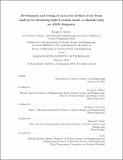| dc.contributor.advisor | Dennis G. Whyte and Zachary S. Hartwig. | en_US |
| dc.contributor.author | Kesler, Leigh A.(Leigh Ann) | en_US |
| dc.contributor.other | Massachusetts Institute of Technology. Department of Nuclear Science and Engineering. | en_US |
| dc.date.accessioned | 2019-07-15T20:36:51Z | |
| dc.date.available | 2019-07-15T20:36:51Z | |
| dc.date.copyright | 2019 | en_US |
| dc.date.issued | 2019 | en_US |
| dc.identifier.uri | https://hdl.handle.net/1721.1/121707 | |
| dc.description | This electronic version was submitted by the student author. The certified thesis is available in the Institute Archives and Special Collections. | en_US |
| dc.description | Thesis: Ph. D., Massachusetts Institute of Technology, Department of Nuclear Science and Engineering, 2019 | en_US |
| dc.description | Cataloged from student-submitted PDF version of thesis. | en_US |
| dc.description | Includes bibliographical references (pages 157-163). | en_US |
| dc.description.abstract | While many ex situ measurements exist to measure plasma-facing component (PFC) surfaces of materials extracted from tokamaks, developing a deeper understanding of the dynamics of erosion, redeposition, and fuel retention in these surfaces will require in situ measurements. A first-of-a-kind technique, Accelerator-Based In-Situ Materials Surveillance (AIMS), was developed for this purpose and first demonstrated on Alcator C-Mod to study divertor surfaces with shot-by-shot resolution [1]. However, the original AIMS methods are not applicable to studying the erosion of bulk, high-Z PFCs like molybdenum and tungsten. Thus, a new method of ion beam analysis (IBA) has been developed to expand the capabilities of AIMS to directly measure this high-Z bulk erosion. This new method, called DEA (Depth markers for Evaluating high-Z materials with AIMS), combines the traditional IBA technique of particle-induced gamma emission (PIGE) with implanted depth markers. | en_US |
| dc.description.abstract | The implanted markers enable the study of bulk material by providing a reference to the surface that can be monitored for erosion and redeposition. Implanting the marker eliminates the need for specially-manufactured "marker tiles" formed by deposited layers that can delaminate and otherwise fail under operational conditions. Two variations of this method were developed: ex situ DEA (eDEA) and in situ DEA (iDEA). Both use PIGE spectroscopy with implanted markers, but they take advantage of different features in gamma production cross sections to analyze data. eDEA, which has shown promising results in ex situ analysis of materials exposed in a tokamak, can also be used to validate the use of depth markers. iDEA provides AIMS with the ability to measure in situ high-Z bulk erosion. As part of this thesis, the following ex situ experiments have been carried out to assess the viability of these techniques. | en_US |
| dc.description.abstract | eDEA samples with implanted depth markers have been studied after plasma exposure on the Material and Plasma Evaluation System (MAPES) in the Experimental Advanced Superconducting Tokamak (EAST). Stability of the marker to temperature excursions was studied by exposing samples to temperatures from 200 to 1000C for times from 1 to 24 hours. iDEA samples were implanted at different depths to determine the sensitivity of the technique to depth. Two simulations were developed to allow interpretation of the experimental data and to test the sensitivity, with initial studies showing a match between predicted and experimental results. eDEA measured erosion of 42.0 23.5 nm on one sample exposed in EAST, and iDEA depth markers were located with 40 nm of accuracy. These results show that DEA, as a part of an AIMS experiment, has the appropriate resolution to monitor surfaces inside a tokamak for time-resolved bulk erosion. | en_US |
| dc.description.statementofresponsibility | by Leigh A. Kesler. | en_US |
| dc.format.extent | 163 pages | en_US |
| dc.language.iso | eng | en_US |
| dc.publisher | Massachusetts Institute of Technology | en_US |
| dc.rights | MIT theses are protected by copyright. They may be viewed, downloaded, or printed from this source but further reproduction or distribution in any format is prohibited without written permission. | en_US |
| dc.rights.uri | http://dspace.mit.edu/handle/1721.1/7582 | en_US |
| dc.subject | Nuclear Science and Engineering. | en_US |
| dc.title | Development and testing of an in situ method of ion beam analysis for measuring high-Z erosion inside a tokamak using an AIMS diagnostic | en_US |
| dc.type | Thesis | en_US |
| dc.description.degree | Ph. D. | en_US |
| dc.contributor.department | Massachusetts Institute of Technology. Department of Nuclear Science and Engineering | en_US |
| dc.identifier.oclc | 1103607472 | en_US |
| dc.description.collection | Ph.D. Massachusetts Institute of Technology, Department of Nuclear Science and Engineering | en_US |
| dspace.imported | 2019-07-15T20:36:44Z | en_US |
| mit.thesis.degree | Doctoral | en_US |
| mit.thesis.department | NucEng | en_US |
